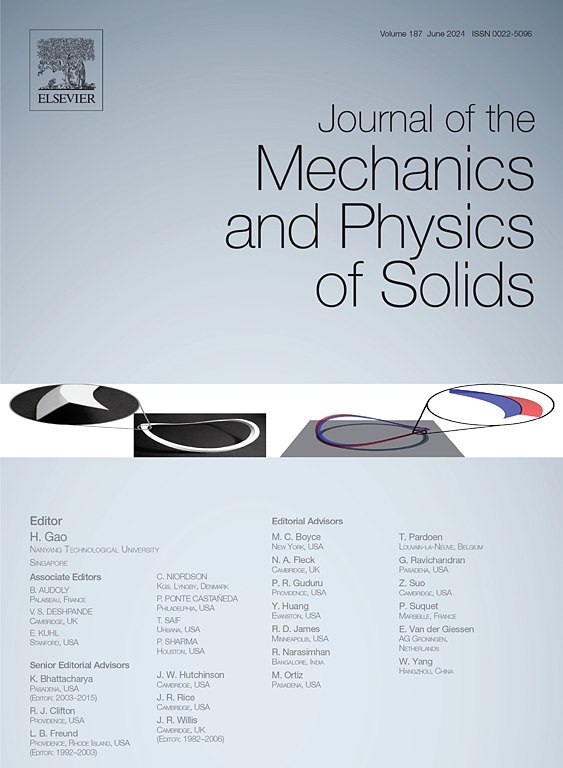Theoretical modeling of phase boundary mediated extra tensile strength and plasticity in high entropy alloys
IF 5
2区 工程技术
Q2 MATERIALS SCIENCE, MULTIDISCIPLINARY
引用次数: 0
Abstract
High-entropy alloys (HEAs) have garnered increasing attention for their remarkable mechanical properties. However, due to the highly complex deformation mechanisms of HEAs, the current understanding of the underlying strengthening mechanisms is not yet fully developed, thereby limiting further microstructure optimization and processing. In this study, we have focused on the mechanics and theoretical modeling of Al0.7CoCrFeNi eutectic HEAs processed by high pressure high temperature (HPHT) treatment. Our experimental results show the HPHT treatment can lead to the formation of hexagonal-like dual-phase microstructures and coherent phase boundaries with approximately doubled tensile strength and ductility. The deformation process of HPHT-treated HEAs encompasses multiple strengthening effects, including dislocation-based Taylor hardening (resulting from both statistically stored dislocations and geometrically necessary dislocations), Hall-Petch hardening, back-stress strengthening, and twinning effect. To comprehensively understand the origins of enhanced strength and ductility in HPHT-treated HEAs, we have established a constitutive theoretical model considering the multiple deformation mechanisms in the HEA samples, especially those mediated by phase boundaries, followed by crystal plasticity finite element simulations of their contributions to the mechanical properties. To ensure compatibility at large deformation, we have also proposed an algorithm for the calculation of geometrically necessary dislocations within reduced integration elements. The simulation results reveal that the enhanced coherence of phase boundaries induced by HPHT treatment is key to the activation of Taylor hardening, back-stress strengthening, and deformation twinning in the face-centered cubic (FCC) phase. Besides, due to the effective suppression of localized interface cracking, the plastic deformability of B2 phases is also enhanced, thus enabling the synergy of strength and ductility in the dual-phase system. These findings promote the understanding of strengthening mechanisms in HPHT-treated eutectic HEAs. More importantly, the constitutive model provided in this study can help theoretical investigation and quantitative analysis of metallic materials with notable interfacial effects on deformation mechanisms and mechanical properties.
求助全文
约1分钟内获得全文
求助全文
来源期刊
CiteScore
9.80
自引率
9.40%
发文量
276
审稿时长
52 days
期刊介绍:
The aim of Journal of The Mechanics and Physics of Solids is to publish research of the highest quality and of lasting significance on the mechanics of solids. The scope is broad, from fundamental concepts in mechanics to the analysis of novel phenomena and applications. Solids are interpreted broadly to include both hard and soft materials as well as natural and synthetic structures. The approach can be theoretical, experimental or computational.This research activity sits within engineering science and the allied areas of applied mathematics, materials science, bio-mechanics, applied physics, and geophysics.
The Journal was founded in 1952 by Rodney Hill, who was its Editor-in-Chief until 1968. The topics of interest to the Journal evolve with developments in the subject but its basic ethos remains the same: to publish research of the highest quality relating to the mechanics of solids. Thus, emphasis is placed on the development of fundamental concepts of mechanics and novel applications of these concepts based on theoretical, experimental or computational approaches, drawing upon the various branches of engineering science and the allied areas within applied mathematics, materials science, structural engineering, applied physics, and geophysics.
The main purpose of the Journal is to foster scientific understanding of the processes of deformation and mechanical failure of all solid materials, both technological and natural, and the connections between these processes and their underlying physical mechanisms. In this sense, the content of the Journal should reflect the current state of the discipline in analysis, experimental observation, and numerical simulation. In the interest of achieving this goal, authors are encouraged to consider the significance of their contributions for the field of mechanics and the implications of their results, in addition to describing the details of their work.

 求助内容:
求助内容: 应助结果提醒方式:
应助结果提醒方式:


